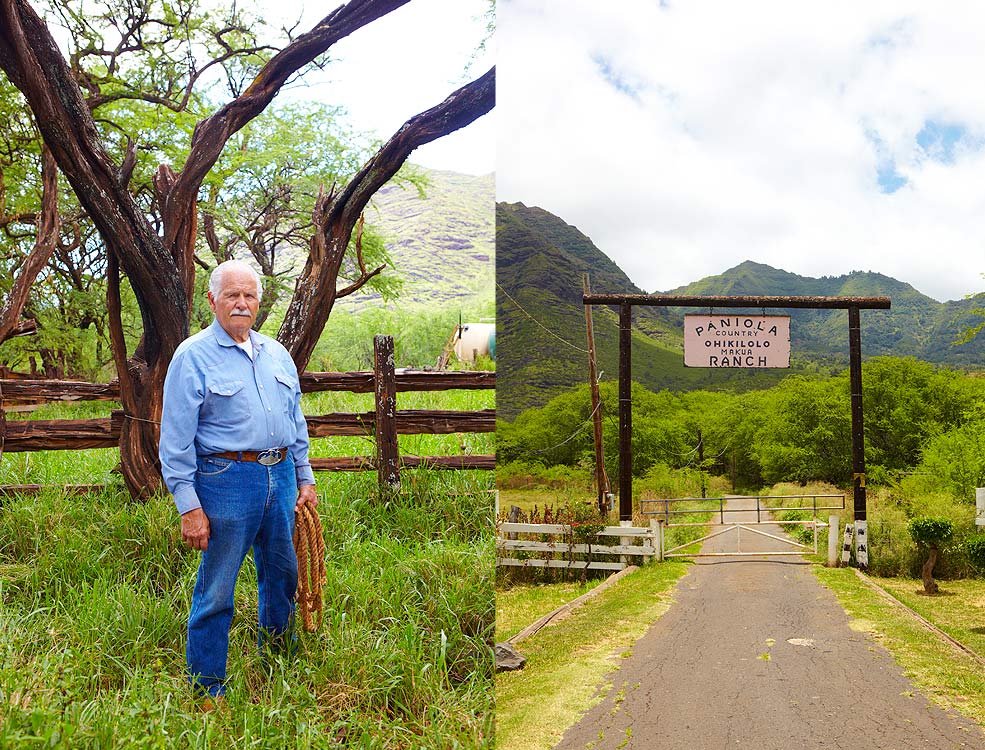For Albert Silva, the Key to the Future Lies in the Past By Chad Pata
When most people think of the environmental movement, thoughts turn to 21st Century inventions like wind farms and electric cars. But for local cowboy and lifetime resident of the Waianae coast Albert Silva, sustainability is as old as the Hawaiian people themselves.
“Before, the Hawaiians had a barter system—and now we are calling it sustainability!” Silva says with a gleeful laugh. “They had no money, so they had sustainability. If you lived mauka, up the valley, you planted crops. Taro, pumpkin, sweet potatoes. And they brought it makai and traded with the people that fished—vegetables for fish—the original sustainability.”
Silva has spent his life preaching the good word of the old ways, as his family history on the Leeward coast dates back into the 1800s. His grandfather dug some of the earliest wells on O‘ahu.
Silva’s fervor for preservation of the land and the customs of his people led the Waianae Preservation Council to anoint (his word, demonstrating how serious he takes this role) Silva the Konohiki of the ahupua’a that encompasses much of Wai‘anae.
An ahupua’a is a traditional land division used in the islands that runs like a pizza slice from the mountains to the sea. It is the job of the Konohiki to use his knowledge of the environment to help perpetuate the life of the land and its inhabitants.
“It is really a lost responsibility that is given to a person,” says Silva who has held the position for more than 30 years. “That person is supposed to oversee, to make adjustments, to make sure everything stays nice, pono, sustainable.”
The Konohiki does not serve as a cop, but rather as an educator whose position in the community is to show his people the proper way to treat the resources they have been provided. “I am not writing tickets, that is wrong for me. I am here to teach them, to help,” says Silva, who learned this lifestyle growing up as a paniola, a Hawaiian cowboy. “Don’t shoot all the animals, leave some back, don’t touch the wahines, let them propagate. Fish, the ones that don’t know how to swim, let ‘em be. Let ‘em learn how to swim, and then you can take ‘em.
“I try to teach them what is right, that is my responsibility as the Konohiki. I don’t tell them what to do, but what not to do.”
Another thing Silva tells people not to do is mispronouncing his lifelong passion of being a paniola. The common usage today is paniolo, a misnomer that Silva claims comes from the wife of Riley Greenwell, who served as head of Parker Ranch back when Silva was still riding rodeos on the Big Island.
“I tell Mrs. Greenwell it is not paniolo, it is paniola,” remembers Silva. “Do you know what she says to me? ‘Well, you have to have a gender’.”
Silva shakes his head at the memory of a malahini bending the rules of the Hawaiian language to match their own Latin-based paradigm. Yet he acknowledges things have improved from when he was young. Being raised by his Hawaiian mother he was always taught English, even though she spoke fluent Hawaiian. The idea was to learn the new language for the new world, so while he does have a working knowledge of the language, stringing together sentences is still a challenge.
However the generation that followed his grew up during the Hawaiian Renaissance, which saw the embrace of the language and astral navigation. These two aspects make Silva beam with pride, knowing that they helped his own nephew Glenn Silva go on to be director of Hawaiian Studies at UH Hilo.
“From day one his mother talked to him in Hawaiian and look at him now,” says the proud uncle.
While the language may be beyond his mastery, the lifestyle and values are not. He ran the Ohikiolo Ranch for many years, raising livestock and tending the land as the generations before him did. Each year he would open the property up for a lu‘au and cattle branding the day before Mother’s Day. Everyone was invited and thousands would attend.
“It was not about money, it was about life, niceness, sharing,” says Silva. “We never charged anyone anything, because it was to give back, and we had the branding for the youngsters, and—hooo!—they loved it! When you give it away it gives it a spiritual aspect; if you charge for it, money comes, money goes, there is no value. This way, it meant something.”
Reminding the residents of these important aspects of their heritage remains his duty to this day. And at 82, Silva is showing no signs of slowing down.
“I just hope these thoughts don’t get lost,” says Silva, whose mother lived to be 98, “because the bigger picture of sustainability is forever present, but its roots come from right here. We want to practice it, continue it, for future generations of Hawaiians.”
